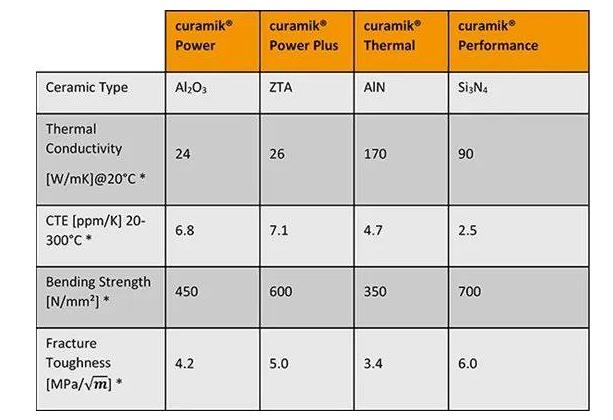Ceramic substrates are commonly used in power modules and have exceptional thermal, mechanical and electrical properties that make them ideal for demanding power electronics applications. These substrates fulfil the electrical function of the system, provide mechanical stability and excellent thermal performance to meet the requirements of a wide range of unique designs.
Advantages of Ceramic Substrates

ceramic substrates
Ceramic substrates are typically located in the copper/metal composite of power modules and act as part of the power electronics circuit. They help to provide PCB-like functionality and enable them to work well as intended. The diagram below shows typical substrate locations and functions.
Ceramic substrates have many advantages over other metal or plastic based substrates.Rogers curamik ceramic substrates have excellent thermal performance, such as high thermal conductivity, greater thermal capacity and improved heat dissipation.Their low coefficient of thermal expansion enables a number of mechanical advantages to be realised,which makes them suitable for particularly important applications. In addition to this, they have a strong electrical insulation capability,which protects the user from the effects of electrical systems.
Types of ceramic substrates
To optimise the performance of a system, the right substrate must be selected for the application.Our Advanced Electronics Solutions team can help you select the ideal substrate and find the ideal balance between mechanical parameters, thermal performance and cost.
ROGERS' curamik product portfolio includes curamik Power, curamik Power Plus, curamik Thermal and curamik Performance substrates.

Types of ceramic Substrates
Applications of Rogers Substrates
Ceramic substrates are used in many of the world's most advanced electronic systems,including the growing renewable energy and automotive electrification industries. Below are just a few of the important markets and applications that can benefit from curamik substrates.
1.Electric and hybrid vehicles and vehicle electrification
Thanks to advances in vehicle electrification technology,the comfort and safety of today's vehicles has increased significantly.Vehicle manufacturers are also aiming to upgrade their powertrains from mild hybrids to fully electric systems to meet the growing demand for low-emission vehicles.
Higher levels of electrification require the use of more electricity.High-current,high-voltage solutions are needed to drive new electrical functions within tight mechanical limits. Due to their superior quality, Rogers substrates are used in a wide range of market application scenarios, including electric power steering,electric braking systems,integrated starter alternators,diesel and water pump controls, motor and engine controls, HEV/EV converters/inverters, LED lighting, and AC generators.
2.Renewable Energy
Rogers substrates are used in a variety of application scenarios throughout the renewable energy industry, including technologies for wind and solar power generation and storage, such as inverters for photovoltaic (PV) and wind and concentrators for concentrating photovoltaic (CPV).
3.Industrial
Rogers curamik substrates perform well in a wide range of general industrial application scenarios.Some of the industrial application scenarios for ceramic substrates include pump controls, inverter drives, traction drives, power supplies, Peltier coolers, custom motor controls,standardised transistor modules for on-board wafers,DC/DC converters and AC/DC converters.
4.White Goods
Consumer preferences for energy efficiency,noise control, ease of maintenance and safety features influence their demand for large home appliances, also known as white goods. Rogers substrates are used in a wide range of major home appliances, including smart power modules that drive appliance motors.
Rogers has nearly 40 years of expertise in metal ceramic bonding technology and is a trusted leader in direct bonded copper (DBC) and activated metal brazing (AMB) ceramic substrates under the curamik brand.